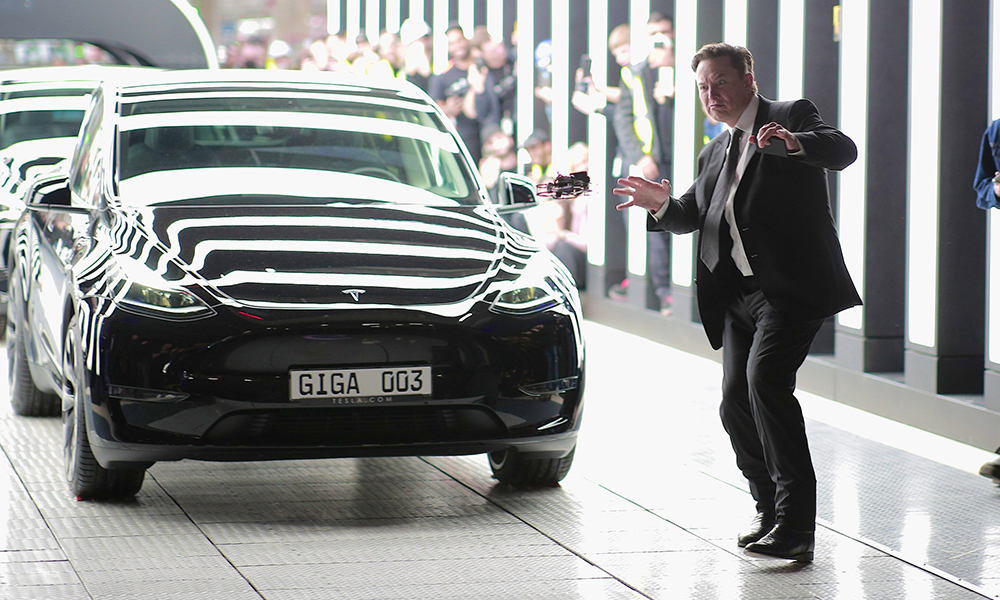
特斯拉(Tesla)公布第三季度業(yè)績時,分析師和金融媒體主要關(guān)注的是,這些數(shù)據(jù)與他們已經(jīng)很負(fù)面的預(yù)測相差多大。特斯拉在萬圣節(jié)前發(fā)布的業(yè)績報告,實際上是今年最恐怖的意外,因為在金融市場的歷史上,很少有企業(yè)能像這家電動汽車巨頭一樣,激發(fā)出華爾街恣意的樂觀情緒。
特斯拉公布了兩年內(nèi)最低的季度每股收益,只有66美分,比外界共同預(yù)測的每股收益低10%。特斯拉令人震驚的糟糕業(yè)績令投資者感到不安,導(dǎo)致特斯拉股價從10月17日收盤時的254美元,下跌到10月19日午后的220美元,跌幅達(dá)13%,使特斯拉的市值縮水超過900億美元。
在營收電話會議上,埃隆·馬斯克各種沉悶的言論,似乎就是為了打消人們對特斯拉很快就能扭轉(zhuǎn)局面的期待。馬斯克警告稱,其最新車型Cybertruck“以人們可以承受的價格達(dá)到量產(chǎn)面臨巨大問題”。他補(bǔ)充道,由于車主現(xiàn)在貸款購買Model 3和Model Y的利率快速升高,他需要持續(xù)降價,才能維持較低月供,使大眾買得起特斯拉汽車。這個承諾意味著特斯拉曾經(jīng)超高的利潤率會持續(xù)下降。他暗示特斯拉迄今為止的飛速擴(kuò)張現(xiàn)在遭遇了大數(shù)定律。他表示,“永遠(yuǎn)維持50%的復(fù)合增長率是不可能的。”
馬斯克對于無人駕駛出租車,甚至也不像以往那么樂觀。在之前的電話會議上,馬斯克強(qiáng)調(diào),特斯拉將很快向數(shù)以百萬計的現(xiàn)有車主提供完全自動駕駛軟件,他們每天可以把自己的車出租,相當(dāng)于個人的Uber,這能為他們創(chuàng)造額外的收入,汽車價值將因此達(dá)到車主購車的五倍。但這一次,他卻一反常態(tài)地沒有給出提供無人駕駛出租車技術(shù)的時間表,甚至警告完全自動駕駛軟件“尚未準(zhǔn)備進(jìn)入主流應(yīng)用”。
對于特斯拉投資者而言,這番言論令他們非常失望。投資者之所以認(rèn)為特斯拉是特別的,相信它能維持?jǐn)?shù)千億甚至數(shù)萬億美元的市值,都取決于馬斯克是否有能力將該汽車公司轉(zhuǎn)變成超級有利可圖的科技公司。他在會上重申,只要特斯拉能夠引領(lǐng)無人駕駛出租車革命,“我們將擁有一家具備軟件公司利潤率的硬件公司”。
但數(shù)據(jù)令人難以信服。
從數(shù)據(jù)上看,特斯拉更像是那些艱難前行的汽車業(yè)同行,而不是飛速增長的科技公司。
無論是特斯拉的最新業(yè)績,還是馬斯克“抑制樂觀情緒”的言論,都表明特斯拉沒有特殊之處,而是應(yīng)該將它與其他汽車廠商歸為同一類。特斯拉在金屬車架里加入了前所未見的創(chuàng)新,它的盈利能力本應(yīng)與蘋果(Apple)或甲骨文(Oracle)相當(dāng),任何重工業(yè)制造商都難以企及。雖然馬斯克作為罕見通過電動汽車獲利豐厚的制造商,取得了巨大成功,但過去幾天的證據(jù)表明,特斯拉首先是一家汽車廠商。未來它極有可能與利潤率相對較低的競爭對手有相同的命運(yùn)。
最好的證據(jù)就是:特斯拉目前只有小幅盈利,而且利潤越來越少。這是通過分析特斯拉不斷增長的資產(chǎn)生成的自由現(xiàn)金流得出的結(jié)論。這些資產(chǎn)是生產(chǎn)更多特斯拉所必需的,如工廠、機(jī)械、庫存和資產(chǎn)負(fù)債表上的其他各種重要項目等。現(xiàn)金流是指支付生產(chǎn)產(chǎn)品需要的所有費(fèi)用,扣除維持工廠的全面更新和進(jìn)行未來擴(kuò)張投資所需要的資本支出之后剩余的資金。簡而言之,自由現(xiàn)金流最終會以股息、回購或推動股價上漲的形式支付給投資者。一家公司通過增加資本投入產(chǎn)生的自由現(xiàn)金流越多,能給股東帶來的收入就越多。
特斯拉的問題在于,其營收減去支出所產(chǎn)生的“經(jīng)營業(yè)務(wù)現(xiàn)金流”持續(xù)減少,而資本支出卻快速增長。結(jié)果就是,特斯拉的自由現(xiàn)金流越來越少,工廠和其他資產(chǎn)卻越來越多。
2021年,特斯拉每季度平均自由現(xiàn)金流為12.2億美元,年均自由現(xiàn)金流為48.8億美元,資產(chǎn)為570億美元,資產(chǎn)回報率達(dá)到8.5%。第二年,自由現(xiàn)金流達(dá)到每季度13.5億美元或每年54億美元,但其資產(chǎn)卻大幅增長到730億美元,資產(chǎn)回報率小幅下降至7.3%。
2023年,情況更加惡化。在前三個季度,特斯拉每個季度的平均自由現(xiàn)金流只有3.58億美元,按年化計算為14億美元。但其資產(chǎn)在短短九個月內(nèi)卻增長了25%,達(dá)到910億美元,這種雙重下降的情況使特斯拉的資產(chǎn)回報率下降到只有1.5%。一個重要原因是特斯拉的資本支出從2022年的每年53億美元,到今年已經(jīng)達(dá)到90億美元。
這些數(shù)據(jù)與科技行業(yè)超級明星公司相比如何?馬斯克曾承諾特斯拉的盈利能力要達(dá)到或者至少接近這些公司。以蘋果、微軟(Microsoft)和甲骨文為例。這三家公司過去四個季度的資產(chǎn)回報率分別為28%、15%和17%,都是特斯拉的數(shù)倍。
另一方面,福特(Ford)的自由現(xiàn)金流與資產(chǎn)比率為2.0%,而大眾汽車(Volkswagen)為2.6%,恰好都與特斯拉相當(dāng)。從馬斯克在營收電話會議上的“世界是殘酷的”這種言論可以看出,就連他似乎也并不完全否認(rèn)這種觀點。特斯拉可能依舊會是一家非常成功的汽車公司,但越來越明顯的一點是,在一個殘酷的、競爭激烈的重工業(yè)制造領(lǐng)域,保持領(lǐng)先是特斯拉的支持者們可以期待的最好結(jié)果。(財富中文網(wǎng))
翻譯:劉進(jìn)龍
審校:汪皓
特斯拉(Tesla)公布第三季度業(yè)績時,分析師和金融媒體主要關(guān)注的是,這些數(shù)據(jù)與他們已經(jīng)很負(fù)面的預(yù)測相差多大。特斯拉在萬圣節(jié)前發(fā)布的業(yè)績報告,實際上是今年最恐怖的意外,因為在金融市場的歷史上,很少有企業(yè)能像這家電動汽車巨頭一樣,激發(fā)出華爾街恣意的樂觀情緒。
特斯拉公布了兩年內(nèi)最低的季度每股收益,只有66美分,比外界共同預(yù)測的每股收益低10%。特斯拉令人震驚的糟糕業(yè)績令投資者感到不安,導(dǎo)致特斯拉股價從10月17日收盤時的254美元,下跌到10月19日午后的220美元,跌幅達(dá)13%,使特斯拉的市值縮水超過900億美元。
在營收電話會議上,埃隆·馬斯克各種沉悶的言論,似乎就是為了打消人們對特斯拉很快就能扭轉(zhuǎn)局面的期待。馬斯克警告稱,其最新車型Cybertruck“以人們可以承受的價格達(dá)到量產(chǎn)面臨巨大問題”。他補(bǔ)充道,由于車主現(xiàn)在貸款購買Model 3和Model Y的利率快速升高,他需要持續(xù)降價,才能維持較低月供,使大眾買得起特斯拉汽車。這個承諾意味著特斯拉曾經(jīng)超高的利潤率會持續(xù)下降。他暗示特斯拉迄今為止的飛速擴(kuò)張現(xiàn)在遭遇了大數(shù)定律。他表示,“永遠(yuǎn)維持50%的復(fù)合增長率是不可能的。”
馬斯克對于無人駕駛出租車,甚至也不像以往那么樂觀。在之前的電話會議上,馬斯克強(qiáng)調(diào),特斯拉將很快向數(shù)以百萬計的現(xiàn)有車主提供完全自動駕駛軟件,他們每天可以把自己的車出租,相當(dāng)于個人的Uber,這能為他們創(chuàng)造額外的收入,汽車價值將因此達(dá)到車主購車的五倍。但這一次,他卻一反常態(tài)地沒有給出提供無人駕駛出租車技術(shù)的時間表,甚至警告完全自動駕駛軟件“尚未準(zhǔn)備進(jìn)入主流應(yīng)用”。
對于特斯拉投資者而言,這番言論令他們非常失望。投資者之所以認(rèn)為特斯拉是特別的,相信它能維持?jǐn)?shù)千億甚至數(shù)萬億美元的市值,都取決于馬斯克是否有能力將該汽車公司轉(zhuǎn)變成超級有利可圖的科技公司。他在會上重申,只要特斯拉能夠引領(lǐng)無人駕駛出租車革命,“我們將擁有一家具備軟件公司利潤率的硬件公司”。
但數(shù)據(jù)令人難以信服。
從數(shù)據(jù)上看,特斯拉更像是那些艱難前行的汽車業(yè)同行,而不是飛速增長的科技公司。
無論是特斯拉的最新業(yè)績,還是馬斯克“抑制樂觀情緒”的言論,都表明特斯拉沒有特殊之處,而是應(yīng)該將它與其他汽車廠商歸為同一類。特斯拉在金屬車架里加入了前所未見的創(chuàng)新,它的盈利能力本應(yīng)與蘋果(Apple)或甲骨文(Oracle)相當(dāng),任何重工業(yè)制造商都難以企及。雖然馬斯克作為罕見通過電動汽車獲利豐厚的制造商,取得了巨大成功,但過去幾天的證據(jù)表明,特斯拉首先是一家汽車廠商。未來它極有可能與利潤率相對較低的競爭對手有相同的命運(yùn)。
最好的證據(jù)就是:特斯拉目前只有小幅盈利,而且利潤越來越少。這是通過分析特斯拉不斷增長的資產(chǎn)生成的自由現(xiàn)金流得出的結(jié)論。這些資產(chǎn)是生產(chǎn)更多特斯拉所必需的,如工廠、機(jī)械、庫存和資產(chǎn)負(fù)債表上的其他各種重要項目等。現(xiàn)金流是指支付生產(chǎn)產(chǎn)品需要的所有費(fèi)用,扣除維持工廠的全面更新和進(jìn)行未來擴(kuò)張投資所需要的資本支出之后剩余的資金。簡而言之,自由現(xiàn)金流最終會以股息、回購或推動股價上漲的形式支付給投資者。一家公司通過增加資本投入產(chǎn)生的自由現(xiàn)金流越多,能給股東帶來的收入就越多。
特斯拉的問題在于,其營收減去支出所產(chǎn)生的“經(jīng)營業(yè)務(wù)現(xiàn)金流”持續(xù)減少,而資本支出卻快速增長。結(jié)果就是,特斯拉的自由現(xiàn)金流越來越少,工廠和其他資產(chǎn)卻越來越多。
2021年,特斯拉每季度平均自由現(xiàn)金流為12.2億美元,年均自由現(xiàn)金流為48.8億美元,資產(chǎn)為570億美元,資產(chǎn)回報率達(dá)到8.5%。第二年,自由現(xiàn)金流達(dá)到每季度13.5億美元或每年54億美元,但其資產(chǎn)卻大幅增長到730億美元,資產(chǎn)回報率小幅下降至7.3%。
2023年,情況更加惡化。在前三個季度,特斯拉每個季度的平均自由現(xiàn)金流只有3.58億美元,按年化計算為14億美元。但其資產(chǎn)在短短九個月內(nèi)卻增長了25%,達(dá)到910億美元,這種雙重下降的情況使特斯拉的資產(chǎn)回報率下降到只有1.5%。一個重要原因是特斯拉的資本支出從2022年的每年53億美元,到今年已經(jīng)達(dá)到90億美元。
這些數(shù)據(jù)與科技行業(yè)超級明星公司相比如何?馬斯克曾承諾特斯拉的盈利能力要達(dá)到或者至少接近這些公司。以蘋果、微軟(Microsoft)和甲骨文為例。這三家公司過去四個季度的資產(chǎn)回報率分別為28%、15%和17%,都是特斯拉的數(shù)倍。
另一方面,福特(Ford)的自由現(xiàn)金流與資產(chǎn)比率為2.0%,而大眾汽車(Volkswagen)為2.6%,恰好都與特斯拉相當(dāng)。從馬斯克在營收電話會議上的“世界是殘酷的”這種言論可以看出,就連他似乎也并不完全否認(rèn)這種觀點。特斯拉可能依舊會是一家非常成功的汽車公司,但越來越明顯的一點是,在一個殘酷的、競爭激烈的重工業(yè)制造領(lǐng)域,保持領(lǐng)先是特斯拉的支持者們可以期待的最好結(jié)果。(財富中文網(wǎng))
翻譯:劉進(jìn)龍
審校:汪皓
When Tesla unveiled its results for its third quarter, analysts and the financial press mostly focused on how far the numbers fell short of the already negative forecasts. The pre-Halloween report indeed uncorked one of the year’s most ghoulish surprises, given that few enterprises in the annals of financial markets have inspired the kind of unbridled optimism with which Wall Street has showered the EV giant.
Tesla posted its lowest quarterly earnings per share in two years at 66 cents, a figure that lagged consensus estimates by 10%. The stunningly bad numbers spooked investors, who sent its stock tumbling over 13% from $254 at the market close on October 17 to $220 by the early afternoon of October 19, a drop that erased over $90 billion of market capitalization.
On the earnings call, Elon Musk’s various dour comments seemed tailored to chill hopes that Tesla’s fortunes would soar any time soon. The CEO warned that the Cybertruck, Tesla’s newest model, will “face enormous problems reaching volume production at a price people can afford.” Because the interest rates that buyers are now paying to finance their Model 3s and Model Ys jumped so fast, he added, he’ll need to keep slashing prices to keep monthly payments down so that his vehicles are affordable for the masses. That pledge suggests that Tesla’s once ultra-high margins will keep shrinking. He implied that Tesla’s heretofore sorcerous expansion is now bumping against the law of large numbers, stating, “It’s not possible to have a 50% compound growth rate forever.”
Musk even dialed down his usual happy talk on robo-taxis. During previous calls, Musk stressed that Tesla will soon provide Full Self Driving software to millions of existing owners who can then rent out their cars for dozens of hours a day as the equivalent of personal Ubers, generating extra income that will make the vehicles worth five times what his customers paid for them. This time, he uncharacteristically provided no timetable for when the robo-taxi technology will become available, and even cautioned that FSD “isn’t ready for prime time.”
For Tesla investors, that admission is a major downer. The view that Tesla is special, that it can sport a market cap in the high hundreds of billions—or even trillions—depends on Musk’s ability to transform the carmaker into a super lucrative tech sprinter. On the call, he reprised the the pledge that once Tesla orchestrates the robotaxi revolution, “then we’ll have a hardware company with software margins.”
The numbers, though.
Tesla’s numbers have more in common with slogging autom peers than tech’s shooting stars
What Tesla’s new numbers are showing, and Musk’s new “squelch the optimism” narrative suggests, isn’t so special at all, and should in fact be grouped alongside rival carmakers. By loading never-before-seen innovations into a metal frame, it was meant to achieve the profitability not of a heavy manufacturer, but of an Apple or Oracle. Although Musk has scored a fantastic coup by becoming the rare producer to earn good money on EVs, the evidence of the last few days shows that Tesla is chiefly a carmaker. And its future will most likely track that of its relatively low-margin competitors.
The best evidence: Tesla is now only modestly profitable, and getting less so. That’s the conclusion from analyzing how much free cash flow it’s generating from its ever-growing assets required to make more Teslas: plants, machinery, inventories, and sundry other balance-sheet staples. Cash flow is what’s left over after paying all expenses required to produce the product, then subtracting the capital expenditures necessary to both keep the plants fully updated and invest for future expansion. Put simply, free cash flow is what eventually goes into the pockets of investors, either in dividends, buybacks, or the fuel for stock appreciation. And the more gobs of FCF a company can generate from adding dollops of capital, the more it will enrich its shareholders.
Tesla’s got a problem here, in that the “cash flow from operations” it generates from revenues less expenses keeps dropping, and its capex keeps rapidly rising. The upshot is that Tesla clinches less and less free cash flow and more and more factories and other assets.
In 2021, Tesla registered average FCF per quarter of $1.22 billion, at an annualized rate of $4.88 billion, on assets of $57 billion, which yields a return on assets of 8.5%. The next year, FCF jumped to $1.35 billion per quarter, or $5.4 billion a year, but assets rose sharply to $73 billion, lowering ROA slightly to 7.3%.
The situation deteriorated in 2023. Through the first three quarters, Tesla has averaged FCF of just $358 million a quarter, or $1.4 billion annualized. But its assets in just nine months have soared by 25% to $91 billion, a lose-lose combination that lowered its ROA to a paltry 1.5%. A big reason is the sharp rise in capex from an annual run rate of $5.3 billion in 2022 to almost $9 billion this year.
How do those numbers compare to the tech superstars whose profitability Musk promises to reach, or at least approach? For Apple, Microsoft, and Oracle. respectively, ROA over the past four quarters was 28%, 15%, and 17%, all multiples of Tesla’s performance.
On the other hand, Ford posted a free-cash-flow-to-assets ratio of 2.0%, and Volkswagen did 2.6%: both right in Tesla’s neighborhood. Even Musk doesn’t seem to totally disagree, given his newfound “the world is tough” rhetoric on the call. Tesla could well continue on as a highly successful car company, but it’s becoming increasingly clear that being a champ in a rough, brutally competitive sphere of heavy manufacturing may be the best that the Tesla believers can hope for.






